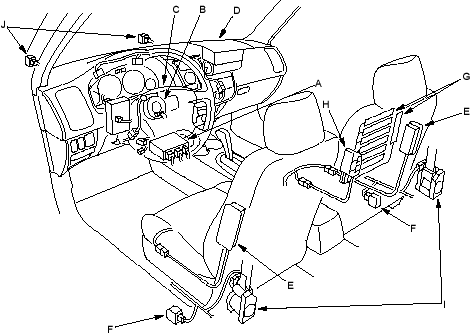
SRS
|
23-49 |
SRS Components
Airbags
The SRS is a safety device which, when used in conjunction with the seat belt, is designed to help protect the driver and front passenger in a frontal impact exceeding a certain set limit. The system consists of the SRS unit, including safing sensor and impact sensor (A), the cable reel (B), the driver's airbag (C), the front passenger's airbag (D), side airbags (E), seat belt tensioners (I) and front impact sensors (J).
Side Airbags
The side airbags (E) are in each front seat-back. They help protect the upper torso of the driver or front seat passenger during a moderate to severe side impact. Sensors (F) in each door sill and in the SRS unit detect such an impact and instantly inflate the driver's or the passenger's side airbag. Only one side airbag will deploy during a side impact. If the impact is on the passenger's side, the passenger's side airbag will deploy even if there is no passenger.
Seat Belt Tensioners
The seat belt tensioners are linked with the SRS airbags to further increase the effectiveness of the seat belt. In a front-end collision, the tensioners instantly retract the belt firmly to secure the occupants in their seats.
OPDS
Some models side airbag system include an Occupant Position Detection System (OPDS). This system consists of sensors (G) and a control unit (H) in the front passenger's seat-back. The control unit sends occupant height and position data to the SRS unit. If the SRS unit determines that the front passenger's head is in the deployment path of the side airbag, it will automatically disable the airbag. When the side airbag is disabled, the Side Airbag indicator light in the gauge assembly alerts the driver that the passenger's side airbag will not deploy in a side impact.
